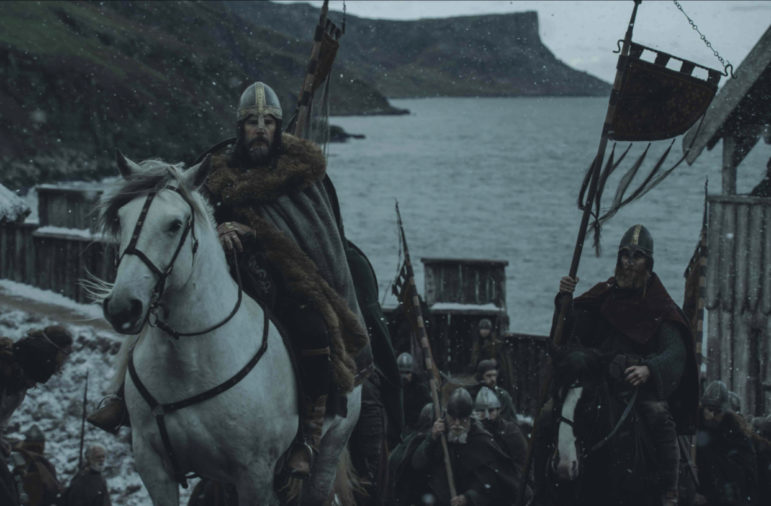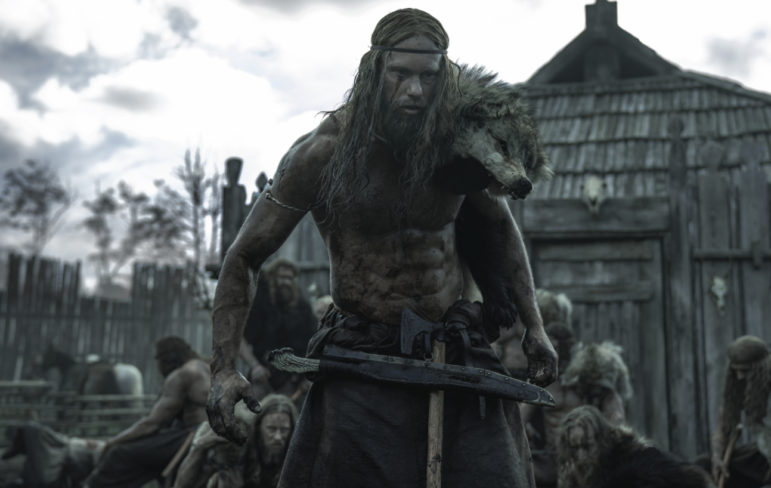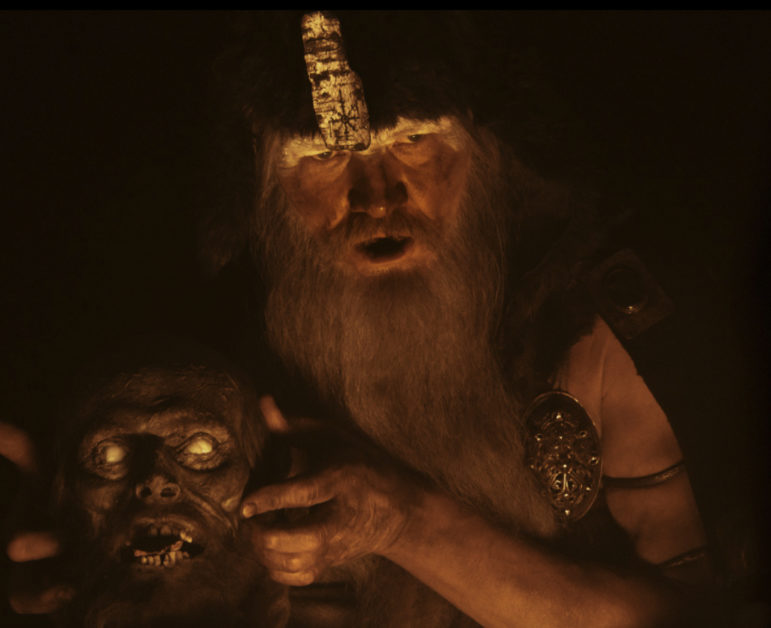
Author’s note: This review will be spoiler-free. The only events that will be discussed in details are from the first fifteen minutes of the movie. Later scenes will only be addressed in a way that won’t reveal any specific or important plot points.
“Hear Ódinn…”
It is with these promise-filled words that Robert Eggers’ The Northman opens its intricate, beautiful, and dramatic tale of fate, love, and revenge. For most of the 2010s, there had been rumors about a Viking-themed movie starring True Blood’s Alexander Skarsgård, but it was not until Robert Eggers became nearly a household name with 2019’s The Lighthouse that something finally materialized.
Co-written by Eggers and Sjón, one of the most celebrated Icelandic novelists of the day, The Northman tells the tale of Amleth (Alexander Skarsgård), a young Scandinavian princeling whose life is turned upside down when his father, the gruff Viking king Aurvandill (Ethan Hawke) is murdered, and his mother (Nicole Kidman) is kidnapped by his deceitful uncle Fjölnir (Clæs Bang).
Now destitute, with nothing left in his young soul but dreams of vengeance and murder, Amleth grows into a violent, cold-hearted raider with little compassion for his fellow man, until, many years later, he hears tidings of Fjölnir’s whereabouts. This sets in motion a series of dramatic and violent events in which faith, vengeance, honor, love, and ancestry collide in an epic tragedy where cold, unwavering fate, more than any individual, is the real protagonist.
Loosely-based upon the story of Amleth (the inspiration for Shakespeare’s Hamlet), a pre-Viking Age legendary king whose story is told in a number of 12th century Danish chronicles, The Northman wears its inspiration on its sleeves. What we are dealing with here is nothing less than a grand medieval Norse saga that never was, transposed onto the silver screen. Like fragments of ancient poetry later turned into prose epics by Dark Age scribes, the movie feels simultaneously real and aestheticized in a way only people who really know the culture and source material they depict could have done.
From a purely historical and cultural standpoint, The Northman shines maybe brighter than any comparable piece of media ever produced. Filmed principally in Ireland but boasting the involvement of significant roster of Scandinavian actors, producers, and technicians, the movie eschews pomp and gratuitous grandiloquence and thus skillfully avoids the trappings that have doomed so many Viking-themed movies and series of ages past.
On the most-handy Viking of Bjornstad Viking movies database website, one can count about 60 feature length movies set in the Viking Age, most of which, according to the site’s reviewers, have little to no value as either art or historical pieces. Nothing could be farther from the truth regarding The Northman. For the first time in many years (decades?), one is presented with a down to earth yet masterfully crafted depiction of not only Viking-Age material culture, but also its lifestyle, beliefs, and worldview. Make no mistake, this picture is no documentary, and takes as much inspiration from post-Viking Age Icelandic sagas as it does from older sources and archeological material, but it still manages to hit the mark splendidly.
For the two-odd hours of the film’s run, the audience won’t be seeing much in terms of horned helmets, sheep-skin cloaks, fashionable eyeliner, or garish face tattoos. Instead, they will see men and women wearing wool. Woolen shirts, woolen cloaks, woolen pants, woolen hoods – in many ways, these are the stars of the show, alongside coarse chainmail armor, timeworn leather, and a whole lot of time-appropriate jewelry. Hearing from my reenactor friends, it looks like few movies, if any, can compare with the magnificent costuming and set design produced for the movie.

A still from “The Northman” (2022) [A24]
Yet, in my eyes, it is in its themes and its depiction of faith, worldview, and rituals that The Northman truly shines. Boasting the participation of Neil Price and Terry Gunnell, some of the most influential researchers within the field of Old Norse religion today, the portrayal of the living religion of the Norsemen is hereby elevated to stratospheric levels of authenticity and artistry.
As someone who has been researching Old Norse religion at the academic level for almost a decade now (the first three of which, incidentally, were under the supervision of none other than Professor Gunnell), watching The Northman put me into a state of unhinged ecstasy more times than I can remember, starting with the opening sequence monologue. There, following an address to the Allfather, a somber voice introduces a tale of vengeance where murderous evildoers and fallen avengers alike will all meet in the resting place of the slain: Valhöll. Not Valhalla, but Valhöll.
For maybe the very first time in a non-Icelandic language movie, the correct term for the hall of Óðinn’s fallen warriors is being used. In terms of linguistics, Valhöll, a feminine substantive noun literally meaning “hall of the slain,” is affected by a sound-shift when declined in the genitive and becomes Valhallar. Because the proposition “til” (towards) takes the genitive in Icelandic (and even, in a fossilized form, continental Scandinavian languages), heading “to Vahöll” becomes til Valhallar, which later was adopted in other languages simply as Vahalla.
The fact that, in the first minute of this big budget movie, The Northman breaks with literally centuries of grammatically incorrect language use, even at the risk of confusing its audience, should tell you everything you need to know when it comes to the level of commitment of its creators.
Still, I cannot but help to mention other precious nuggets scattered throughout the movie: the gullgubber golden foils adorning the posts of the sanctuary, the ritual mask worn by Heimir (Willem Dafoe), clearly inspired by both the Stóraborg and the Hedeby masks, the kennings scattered in speech, alongside direct quotes from eddic poems and sagas, the vocabulary of supernatural beings, to the entombment ritual and beyond. There are too many to count, and all of these, from small set details to entire characters and scenes are exquisitely adapted, not only from a historical-cultural perspective, but also from a narrative and thematic one.
The Northman is indeed, beyond the stellar performance of its main and supporting cast, a movie based upon a central notion: that of fate and the choices we humans have, and those we don’t. Heir of a warlord-king, Amleth is geared from his youngest days toward the bellicose world of war and raiding. Later, lost and dispossessed, he becomes a ferocious fighter, which leads him to commit acts of utmost cruelty, acts that still pale in comparison of what he will have to do to avenge his father. But must he truly engage in yet more bloodshed, hate, and destruction?
Throughout the whole movie, we see characters who, both the strong and the frail, are equally molded, if not broken, by the world around them, thrust into situations they have little control over. Yet, still, that little agency they have, this meager force they retain to affect their own lives and future, can lead to some dark and dreary paths.
If cruelty, murder, and even gore are thus etched into this tale like cuts from the sharpest steel, these are never gratuitous or merely used for shock value. They are instead used to bring the audience into a world where violence is law, and human lives are worth little more than that of cattle. Channeling his experience as a horror movie director, Robert Eggers employs some truly disturbing imagery that is bound to shock anyone with a weak stomach or not of age. (It goes without a saying, The Northman should not be shown to children; it is rated R for a reason).

A still from “The Northman” (2022) [A24]
All of this violence never feels exploitative, though. Instead, it serves a dual purpose: to enthrall the audience and simultaneously make them aware of the horrors man is capable of, especially in times of war and revenge.
This particularly applies to the battle scene set in Russia early in the movie. It starts with a phenomenally intense ritual scene where a chieftain clad as Óðinn dispenses fury and bloodlust to his men before the assault. In the following sequence, as smooth as it is impactful, we see a band of roving Vikings and berserks laying to waste a fortified settlement in a fashion that is clearly designed to beguile the watchers and imprint an image of strength and glorious dominance into their eyes and minds.
When the sequence ends, however, we are left with the remains of dead and dying men, weeping women, terrified children and a ghastly feeling of emptiness and hopelessness. If anyone says that The Northman glorifies violence, they either come from a place of complete intellectual dishonesty or they have not seen the movie (or they are just plain stupid).
The central theme of the movie, how men and women can be crushed by the weight of fate, and the bonds that unite and separate them from others, is indeed one that leaves little place for the celebration of an idealized savage past. Throughout the movie, one can witness the grim reality of murder, oppression, abuse, exploitation, and denial of dignity that is all too common to the human experience. It is a grey and cruel world in which we will not find any hero, not even a reluctant one or an anti-hero.
Agency, in the world of The Northman, is measured by the degree of violence one is willing to inflict upon a fellow man. This is a zero-sum game in which no player comes out as a winner. Anyone who plays a part in this bitter game of revenge, supremacy, and treachery ends up a loser.
Nevertheless, there is also beauty, love, and even hope to be found here. Not only are the sets and locations of The Northman intricately-crafted and rich in colors, lights, and details, but the human element can, despite its bleak settings, lead to some truly poignant moments. In a movie where one can hear, besides English, Russian, Icelandic, and Gaelic, and behold some magnificent pieces of arts and crafts, it is actually the short moments of respite between all the killings where character interactions really shine. This is especially true with those involving our protagonist Amleth, but also, somewhat surprisingly, with his kinslaying uncle Fjölnir.
The depiction of each man’s faith and religious practices also represents a sturdy pillar upon which much of the movie rests and revolves. Amleth, an Óðinn’s man, deals with dark rituals and prayers of war, bloodlust, and martial prowess, while Fjölnir, patriarch of a large estate, worships Freyr and engages in complex rituals of devotion involving no witches, but temple-priests and the members of his estate.
While some of the rituals recreated in The Northman may appear violent and disturbing, there are also others, like the Gaelic fertility ceremony where life-affirming powers of love and human bonds are reaffirmed, and take the plot into less bloody territories.

A still from “The Northman” (2022) [A24]
In many ways, the movie is extremely Pagan-centric. While there are some small references to elements of Abrahamic faiths (such as Amleth’s silver-dinar necklace or an Irish slave making the sign of the cross), the movie avoids yet another pitfall that too often plagues Viking-themed movies, namely centering the conflict between the old and the new faiths. Here, Pagan practices and worldview are given center-stage, more even than the protagonists themselves. It helps centering the action and placing the characters in a more compact, believable world where no outside forces are at play. Instead, the forces of fate, borne and embodied within the protagonists themselves both gird and sustain its dramatic narrative, making for an intense, engaging, but also demanding watch.
In more ways than one, The Northman is destined to stand out. Coming out at what could be the tail end of a wave of popular interest in Viking Age Scandinavia, this picture could just as well single-handedly enliven a genre that has, as of late, been dominated by mainstream productions of dubious historical and aesthetic value. Yet, beyond the confines of Viking-themed entertainment, we are left with a movie that can stand on its own cinematic legs.
While the horror and gore influences will be a make or break for some, no one in their right mind can deny the artistic merits of The Northman. At times as epic as any modern period piece and at times as composed as a historical drama shot in the middle of the previous century, there is much to love and to discover for those more interested in the seventh art than in the world of the Vikings and their gods.
If The Northman becomes, as it rightfully deserves, the new reference for Viking-themed media, it will be a colossal yardstick to compare to. And yet, one can only start dreaming about a future in which the world of Dark Age Scandinavia is neither used for shock value nor mere entertainment, but presented in a dignified, respectful manner which puts both peoples, their faith, and their worldview in the center stage.
If The Northman can manage to ignite a new creative fire and inspire creators into producing new, engaging, and perhaps even somewhat less bloody and cruel depictions of the Viking Age, it will become more than merely a grand, epoch-making cinematic masterpiece: it will forever stand as a proud, indestructible pillar in the history of art.
As the Vǫluspá would say: Vitoð ér enn, eða hvat?
The Wild Hunt is not responsible for links to external content.
To join a conversation on this post:
Visit our The Wild Hunt subreddit! Point your favorite browser to https://www.reddit.com/r/The_Wild_Hunt_News/, then click “JOIN”. Make sure to click the bell, too, to be notified of new articles posted to our subreddit.